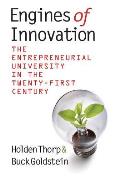- About
- Programs
- Issues
- Academic Freedom
- Political Attacks on Higher Education
- Resources on Collective Bargaining
- Shared Governance
- Campus Protests
- Faculty Compensation
- Racial Justice
- Diversity in Higher Ed
- Financial Crisis
- Privatization and OPMs
- Contingent Faculty Positions
- Tenure
- Workplace Issues
- Gender and Sexuality in Higher Ed
- Targeted Harassment
- Intellectual Property & Copyright
- Civility
- The Family and Medical Leave Act
- Pregnancy in the Academy
- Publications
- Data
- News
- Membership
- Chapters
A Primer on Capitalist Practice for a Modern Research University
Engines of Innovation: The Entrepreneurial University in the Twenty-First Century. Holden Thorp and Buck Goldstein. Chapel Hill: University of North Carolina Press, 2010.
Holden Thorp and Buck Goldstein have crafted a utopian imaginary of an American research university for the future, and they want it yesterday. In their new book, Engines of Innovation: The Entrepreneurial University in the Twenty-First Century, Thorp and Goldstein put forth their vision of the research institution as a dynamic and flexible bastion of interdisciplinary innovation. Relying heavily on faculty entrepreneurship supported by administrative leadership, the authors argue, these institutions should lead the way in addressing and solving the world’s biggest problems. This book is committed fully to capitalist principles and is optimistic about their promise for ensuring the relevance of the U.S. research university.
The book is an easy read, much like a well-written special feature in the New York Times Magazine. It covers a lot of ground, from defining entrepreneurship to reimagining academic roles, from strategizing for organizational change to initiating and sustaining enterprises. Yet the authors remain on message throughout: American research universities must become more entrepreneurial in order to remain relevant and to address society’s big problems in the twenty-first century.
In the first part of Engines of Innovation, the authors provide an extended definition of entrepreneurship and describe its significance in creating their utopian university. Chapter 1 posits that research universities are uniquely prepared for opportunities in this era of globalized knowledge generation and digitized circulation. Thorp and Goldstein see the research university as one of this country’s strongest institutions, well-suited to addressing big problems in modern society—but only if it becomes more market-driven and outcomes-oriented.
The next three chapters explain entrepreneurial science, enterprise creation, and social entrepreneurship. The authors explain how principles of entrepreneurship—including having clear objectives, ensuring measurable accountability, maximizing impact, and getting results—are common across these contexts. Essentially, these are core tenets of capitalism, although Thorp and Goldstein seem reluctant to name them as such. They take pains to avoid talk of markets and profits, opting instead for more palatable (perhaps) language such as “impact” and “results.”
Throughout the book, the authors highlight real academic enterprises that operate entrepreneurially, illuminating the possibilities for change and innovation. Bio-X, an interdisciplinary center at Stanford University, is just such an initiative. At Bio-X, research connected to biology and medicine is conducted with ongoing corporate, government, and nonprofit support.
The second half of Engines of Innovation is dedicated primarily to strategic planning for turning universities into these engines of innovation. Chapters 5–7 focus on dynamic visions of university organization, leadership, and the work life of faculty. Each chapter highlights examples of innovative universities and the people who run them. Because the authors are proponents of capitalist theory, it is not surprising that the most striking examples are drawn from the wealthiest and most independent of campuses. Stanford University, Harvard University, the Massachusetts Institute of Technology, and the University of North Carolina at Chapel Hill (where Thorp is chancellor and Goldstein is university entrepreneur in residence) are repeatedly featured for innovative entrepreneurial pursuits. Thorp and Goldstein describe the essential traits of successful entrepreneurial organizations and individuals—chief among them commitment to useful results. These attributes provide a framework for cultivating and fostering a community of academic entrepreneurs.
Chapter 8 focuses on issues of culture and structure in building entrepreneurial universities. It is in this chapter that Thorp and Goldstein clearly articulate what they only allude to earlier in the book: entrepreneurship is a cultural struggle, not a structural problem. Universities must engage in strategic cultural change, rather than bog down in structural reorganization, if they are to serve as strongholds of innovation. Chapter 9 makes this clear as it instructs about core principles and practices in teaching entrepreneurship.
I would have appreciated mention of the ethnographic endeavor as valuable to academic entrepreneurship for keeping itself honest about its process, outcomes, and consequences. The authors do discuss accountability throughout the book and feature it in chapter 10, but it is framed in positivist and capitalist modes—it proves viability and value by objective measures of wealth accumulation. Chapter 11 reinforces these measures further by validating the role of donors and development. However, if entrepreneurship really is a cultural endeavor (with economic and social outcomes, of course), why would we not rely on the institutionalized study of culture through anthropology and ethnography to strengthen our efforts?
I presume that the authors would never risk such an inquiry, yet I must give credit to Thorp and Goldstein for their painstaking efforts at inclusion. Throughout the book, they seek ways to include the social sciences and humanities. Indeed, interdisciplinarity is critical to Thorp and Goldstein, as is a rather socialist value of sharing credit and wealth. However, they resist attending to issues of wealth distribution.
Despite their descriptions of the many potential benefits of entrepreneurship and stories of promising academic ventures, the authors avoid engaging in critical dialogue about capitalism in higher education or discussing the hidden meanings and unrecognized consequences. It does not take long to figure out that an entrepreneurial university will judge its members by the capital they accumulate. And whereas many fields can contribute to entrepreneurial innovation, not all can leverage the same output from their input. For example, the fields of education and social work will never earn as much as engineering.
When the university becomes a marketplace of enterprises, the threshold of acceptable capital promises to rise and rise. Inevitably, institutions must either accept a multitiered organization or negotiate the differences in capital expenditure and revenue expected to operate or generate across fields of study. Neither avenue promises democracy and egalitarianism.
As a primer for entrepreneurship and capitalist practice in academia, Engines of Innovation succeeds. Anyone concerned about the American research university should read this book to get a glimpse of the marketdriven institution of which we will be a part. Thorp and Goldstein’s argument is clear and convincing—make no mistake, their utopia is en route to becoming ubiquitous truth.
Ryan Evely Gildersleeve is assistant professor of educational leadership and policy studies at Iowa State University. His e-mail address is [email protected].




